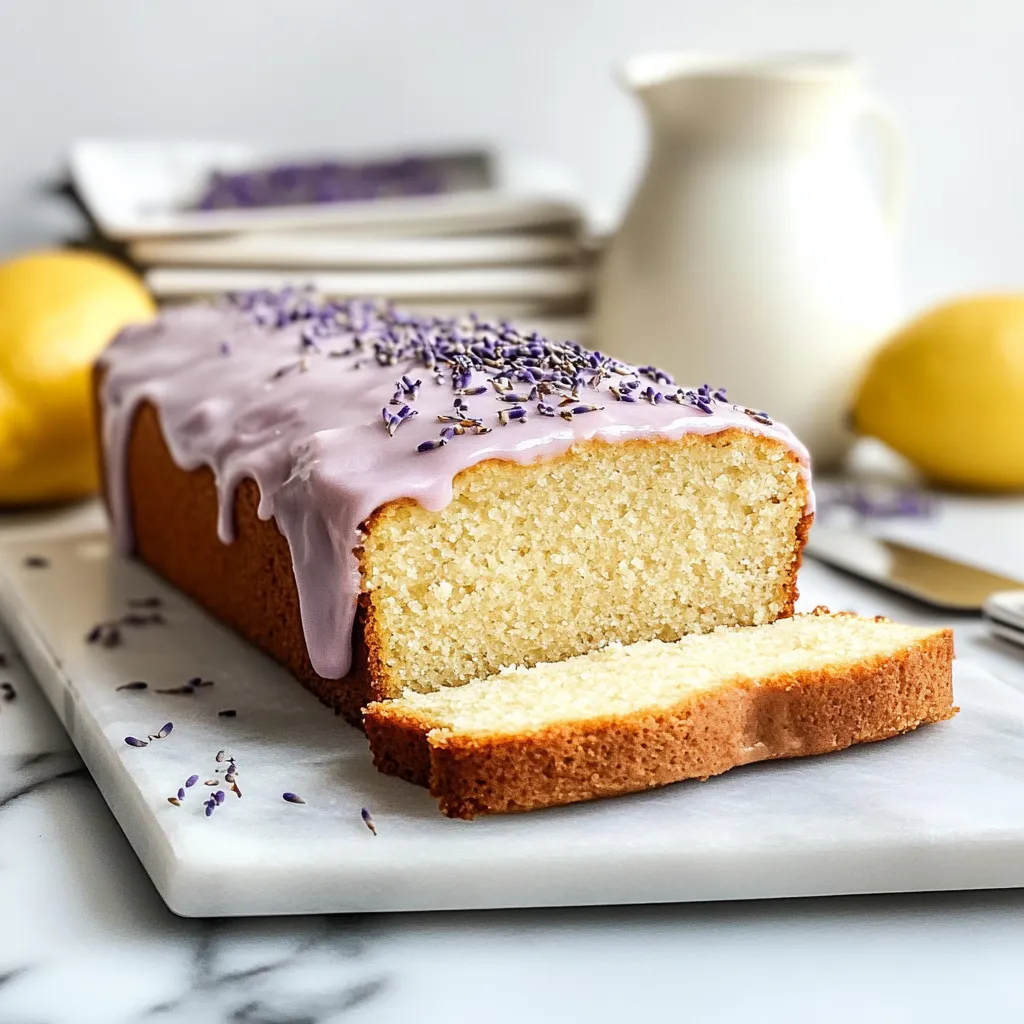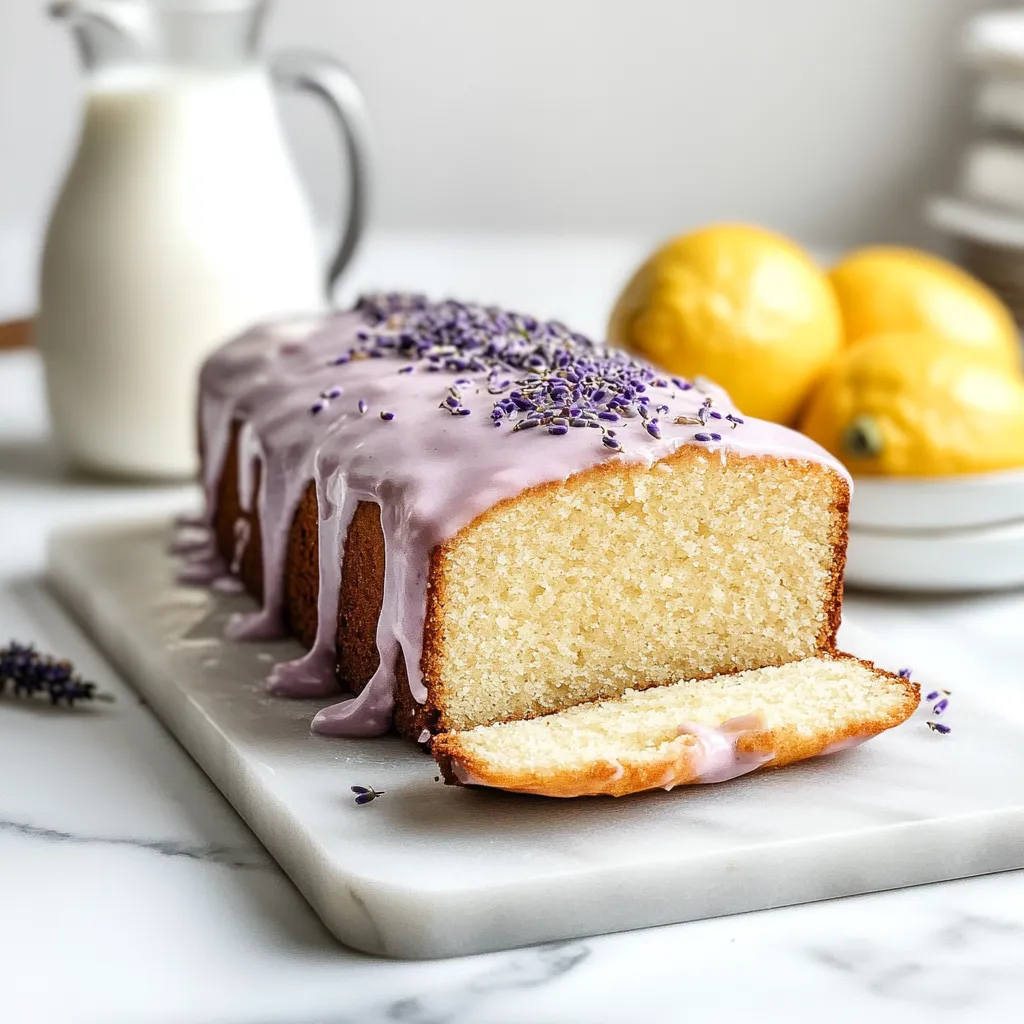 Pin
Pin
Every bite of this Lemon Lavender Loaf brings out the freshest touch of spring, giving you zesty lemon and light hints of lavender that play together just right. The burst of flavor comes from smart tricks—like rubbing lemon peel into sugar to soak up all its oils, fresh lemon juice for a lively kick, and gently warming the lavender in oil to get the best out of those little buds. What you end up with is a super tender loaf. The cake is soft but never soggy. The lemon pops, and right after, you’ll catch that mellow lavender as it fades, making this far more special than your typical lemon bread.
I started tinkering with this when I wanted to catch that mix of lemons and lavender from my grandma's backyard. The first brunch I made it for, everyone went quiet—trying to put their finger on that gentle floral note behind all the lemon. Three people wanted the secret before dessert was done, and even my brother-in-law (he dodges "fancy" treats) asked for it on his birthday. These days, this loaf is my go-to for spring and summer hangs. Every first bite always gets that little moment of surprise and a smile.
Tasty Ingredients
- Canola oil (½ cup): Gives a plush crumb and really draws out the lavender's charm
- Lemons (3 medium): Fresh zest and juice bring out the zippy tartness
- Culinary lavender (2 tablespoons): Adds gentle floral vibes—nothing too perfume-y
- Granulated sugar (1 cup): Sweetens up the loaf and helps the zest do its thing
- Greek yogurt (⅓ cup): Keeps the cake moist and adds a soft tang you’ll love
- All-purpose flour (1¾ cups): This is what gives the loaf good structure
- Vanilla extract (1 teaspoon): Adds a warm backdrop that lets everything else shine
- Large eggs (3): Makes the texture rich and the loaf sliceable
- Salt (½ teaspoon): Brings out all the flavors and stops it from turning too sweet
- Baking powder (2 teaspoons): Gets the loaf to puff up light and fluffy
Making Magic
Infusing Lavender
Get started by building the flavor foundation—blooming that lavender. Warm up your canola oil in a regular pot over medium-high, just enough so it’s hot but not smoking. Move the pot off heat quick, pour in the lavender, and cover it up—this keeps the warmth in and lets the lavender’s scent get into the oil without burning anything. Give it at least half an hour to soak, though an hour’s even better for bolder taste. Strain the oil once you’re done, pressing the lavender to grab every last flavorful drop.
Amping Lemon
As your lavender chills, work on the lemons next. Carefully remove the zest without hitting the white part (that’s pretty bitter), then toss the zest into a bowl with your sugar. With your fingers, really mash and rub them together so the oil in the zest mixes with the sugar—this brightens both the color and smell. You want the sugar to end up pale yellow and super lemony. Set that aside and now juice up the lemons you just zested.
Building Airiness
Dump the eggs, that lemon-sugar mix, and vanilla into a stand mixer bowl. Whip them on high for three or even four minutes—don’t rush this! You’ll watch everything puff up huge, turning pale and foamy. That's the lightness your loaf needs. When you pull the whisk up, it’ll leave silky ribbons behind that slowly melt back in—that’s your cue you’re set for the next step.
Blending in Oil
Keep your mixer going, just not as fast, and slowly spill in your lavender oil bit by bit. You’re doing this steady so you don’t beat all the fluff out of what you’ve just built. When you’re done, beat for another half minute—this checks that it all comes together glossy and totally smooth.
Switching Wet and Dry
In another bowl, mix together your flour, baking powder, and salt until it all blends evenly. Drop about a third of this dry stuff into your batter and mix it on low—don’t work it too hard. Pour in half your yogurt and that fresh lemon juice, mix gently, then add more dry, then wet, ending with the last third of the dry mix. This swapping keeps the loaf tender and evenly baked, not tough. The end result should be silky and pour out easily, kind of like thick pancake batter.
Baking Low and Slow
Spoon the batter into a well-greased 9x5 pan lined with parchment (let the ends hang over for an easy lift later). Bake at 350°F for around 45-50 minutes. You're aiming for golden brown on top and just a couple of sticky crumbs on a toothpick—no wet streaks. Pat the top with your finger; it should bounce back. Baking at this temp means you don’t end up with a big crack down the middle—just an even, tidy loaf.
Cool Down Time
When it’s baked, leave the loaf in its pan for 10 minutes—no peeking! If you try to get it out too early, it might collapse; too late, it might turn out soggy underneath. After 10 minutes, use the parchment to lift it to a rack so it can finish cooling—could take two hours, and it’s worth waiting. Let it cool all the way before you add any glaze, or it’ll just soak in and disappear.
 Pin
Pin
My grandma always said, “Working with flowers in baking takes a soft touch and patience.” If you throw in too much lavender it’ll taste soapy, but if you skimp, you won’t taste it at all—her words stick with me every time I bake this. This loaf gets the balance just right, with lavender doing its thing quietly next to the main star, lemon. I always think of slow afternoons in her kitchen, sunlight pouring in, mixing and tasting. She taught me the best flavors come from giving each thing in your bowl some respect—and putting them together with care.
Serving Ideas
Cut this loaf into thin slices and serve with a big spoonful of barely sweet whipped cream or a dab of crème fraîche. For tea, try it with Earl Grey or a mild white tea so the floral part doesn’t get lost. When summer hits, add a few fresh berries for a pretty touch and a nice taste contrast. Or, heat up a slice and scoop vanilla ice cream on top for a rich finish as the ice cream melts into the warm crumb.
Fun Twists
Switch things up by playing with the add-ins. Try using fresh thyme or rosemary instead of lavender for a more herby punch that still tastes great with lemon. Want winter vibes? Switch out the lemon for orange and skip the lavender for some cardamom. For a splash of color or for a party, add fresh blueberries before baking—they pop with each bite. Looking for something more classic, drop the lavender and use double vanilla, keeping it simple but tasty.
Keeping it Fresh
Store your loaf wrapped airtight at room temp and it'll stay moist for up to four days (and honestly, the lavender gets stronger by day two). For longer keeping, wrap up slices in plastic and freeze them—they’ll last about three months. Just thaw as needed. If it's already glazed, best to eat it within two days, since the glaze will start melting in, but it’ll still taste good even if it looks a bit messy.
I’ve baked more loaves than I can count, but this lemon-lavender one always feels like my biggest win—just the right mix of old school and something new. Watch folks bite in: first the lemon, then a pause when that lavender pops up. The little details aren't just for show—each one bumps up the flavor and makes the loaf a real showstopper. It proves to me that you don’t need to go over the top—use simple stuff, treat it right, and you’ll end up with something people don’t forget.
 Pin
Pin
Common Recipe Questions
- → What does culinary lavender mean and where do I get it?
- Culinary lavender is grown just for eating, not for looks. It's got a gentle flavor. Check fancy grocery stores, local markets, or look online. Grab ones labeled as 'culinary' or 'food grade.'
- → Is it okay to swap dried lavender for fresh?
- Yep, but dried is stronger so you'll need less. Use about a third of the amount called for if you're switching from fresh.
- → How do I keep my loaf from being heavy or dense?
- Don't stir too much after adding flour, use the spoon-and-level method to measure flour, and let all ingredients warm up to room temperature before mixing.
- → What if I don't have a stand mixer?
- No worries! You can use a hand mixer or even do it all with a whisk—just beat the eggs and sugar till they're super pale and fluffy first.
- → How will I know if the loaf is finished baking?
- Put a toothpick in the middle. If it comes out clean or nearly clean, it's ready. The loaf should also feel a little springy and should begin pulling from the pan sides.
